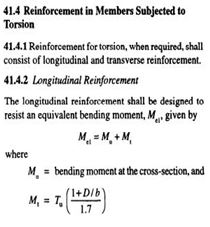What is Releases in beam :-
To understand this first understand equilibrium torsion and compatibility torsion
- Primary or equilibrium torsion, and
- Secondary or compatibility torsion.
The equilibrium torsion is required for the basic static equilibrium of most of the statically determinate structures. Accordingly, this torsional moment must be considered in the design as it is a major component.
The compatibility torsion is required to satisfy the compatibility condition between members. However, statically indeterminate structures may have any of the two types of torsions. Minor torsional effects may be ignored in statically indeterminate structures due to the advantage of having more than one load path for the distribution of loads to maintain the equilibrium. This may produce minor cracks without causing failure. However, torsional moments should be taken into account in the statically indeterminate structures if they are of equilibrium type and where the torsional stiffness of the members has been considered in the structural analysis. It is worth mentioning that torsion must be considered in structures subjected to unsymmetrical loadings about axes. Clause 41 of IS 456 stipulates the above stating that, “In structures, where torsion is required to maintain equilibrium, members shall be designed for torsion in accordance with 41.2, 41.3 and 41.4. However, for such indeterminate structures where torsion can be eliminated by releasing redundant restraints, no specific design for torsion is necessary, provided torsional stiffness is neglected in the calculation of internal forces. Adequate control of any torsional cracking is provided by the shear reinforcement as per cl. 40 .
Note:- Compatibility torsion is dangerous in concrete beams and must be eliminated. That does not necessarily mean releasing the beam ends. It means nullifying torsional stiffness. Steel beams have very small torsional stiffness so there is no issue. If we use steel boxes than we have to model the actual connections… some have torsional capacity some do not.
Compatible torsion ex- parking canopy, in this we cant release. While in equilibrium torsion we can have as it had many other path to go through.
Why we provided release in beam:-
we release moments, because moments of secondary beam acts a torsional effect on primary beams. Because of these, primary beam fail due to torsion.
Is it necessary to release the secondary beam :-
it is not necessary to release the secondary beam but If moment is not released in secondary beam it will develop torsional moment in the primary beam then secondary beams are treated as simply supported Hence while designing primary beam, we need to design for torsion also. In cases of steel structures, in addition to torsion check, we should also design connections accordingly whether rigid or flexible connection.
For RCC frame If a secondary beam is continuous on the primary beams the moment is released only at the discontinuous edge of the beam (i.e. we can provide negative rebar’s for the secondary beams on its continuous edges). See the fig 1.a and 1.b






Sir can you share me etab learning videos
Visit Our Youtube Channel for E-tabs:- Civil Software Tutorials
I want to certain topics in etabs such as
1. Whether stair should be modeled as sloping waist shell or it should be modeled as one-way horizontal membrane.in many occasion where I modeled stair with sloping shell gives absurd time period in modal analysis.
2. Whether column should be avoided in corner of shear wall I.e lift etc.
3. Whether beam between shear wall should be modeled as zero mass beam